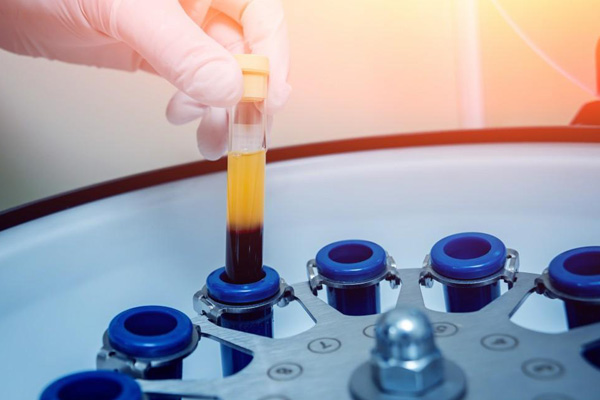
Although blood is mainly a liquid (called plasma), it also contains small solid components (red cells, white cells, and platelets). The platelets are best known for their importance in clotting blood. However, platelets also contain hundreds of proteins called growth factors that are very important in the healing of injuries.
PRP is plasma with many more platelets than what is typically found in blood. The concentration of platelets — and, thereby, the concentration of growth factors — can be 5 to 10 times greater (or richer) than usual.
To develop a PRP preparation, blood must first be drawn from a patient. The platelets are separated from other blood cells and their concentration is increased during a process called centrifugation. These platelets are then injected into the injured site.
How Does PRP Work?
Although it is not exactly clear how PRP works, laboratory studies have shown that the increased concentration of growth factors in PRP can potentially speed up the healing process.
To speed healing, the injury site is treated with the PRP preparation. This can be done in one of two ways:
- PRP can be carefully injected into the injured area. For example, in Achilles tendinitis, a condition commonly seen in runners and tennis players, the heel cord can become swollen, inflamed, and painful. A mixture of PRP and local anesthetic can be injected directly into this inflamed tissue. Afterwards, the pain at the area of injection may actually increase for the first week or two, and it may be several weeks before the patient feels a beneficial effect.
- PRP may also be used to improve healing after surgery for some injuries. For example, an athlete with a completely torn heel cord may require surgery to repair the tendon. Healing of the torn tendon can possibly be improved by treating the injured area with PRP during surgery. This is done by preparing the PRP in a special way that allows it to actually be stitched into torn tissues.
What Conditions are Treated with PRP? Is It Effective?
Research studies are currently being conducted to evaluate the effectiveness of PRP treatment. Recent research has shown that certain tendon problems can have improved outcomes with PRP injections. Additionally, more and more literature is showing the significant effectiveness of PRP in the treatment of mild to moderate knee osteoarthritis. Factors that can influence the effectiveness of PRP treatment include:
- The area of the body being treated
- The overall health of the patient
- Whether the injury is acute (such as from a fall) or chronic (an injury developing over time)
- The preparation of the PRP, including the cellular makeup of the material that is injected
Knee Osteoarthritis
Research has demonstrated the benefit of pain reduction with PRP coupled with gel (HA). Symptomatic patients with knee OA who were injected with a combination of PRP and HA demonstrated greater improvement in pain and function compared with patients who received HA injections only injections.
Chronic Tendon Injuries
According to the research studies currently reported, PRP is effective in the treatment of chronic tendon injuries, especially tennis elbow, a very common injury of the tendons on the outside of the elbow.
The use of PRP for other chronic tendon injuries — such as chronic Achilles tendinitis or inflammation of the patellar tendon at the knee (jumper's knee) is promising. However, it is difficult to say at this time that PRP therapy is any more effective than traditional treatment of these problems.
Acute Ligament and Muscle Injuries
Much of the publicity PRP therapy has received has been about the treatment of acute sports injuries, such as ligament and muscle injuries. PRP has been used to treat professional athletes with common sports injuries like pulled hamstring muscles in the thigh and knee sprains.
Surgery Adjunct
More recently, PRP has been used during certain types of surgery to help tissues heal. It was first thought to be beneficial in shoulder surgery to repair torn rotator cuff tendons. However, the results so far show little or no benefit when PRP is used in these types of surgical procedures. Recent research has been dedicated to the benefit of PRP in meniscus healing after meniscus repair; however, these studies are only in their infancy.





